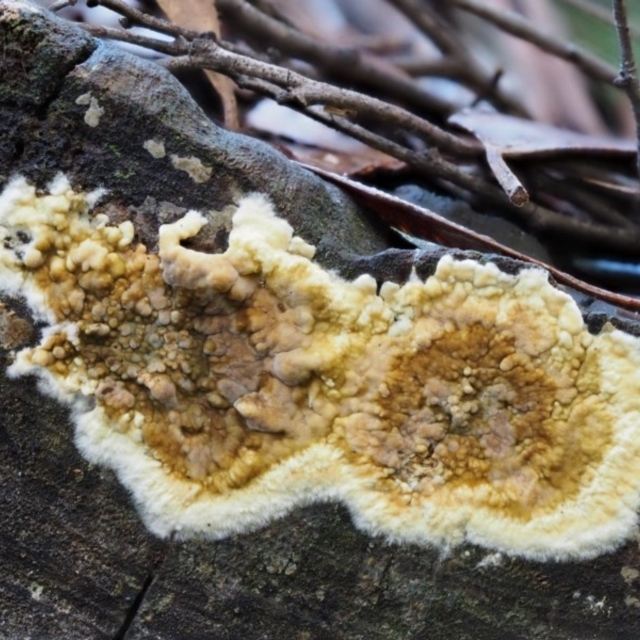Coniophora sp.
The species of Coniophora are corticioid fungi, which means the fruit body is essentially two dimensional and much like an extra skin on the woody substrate. The fruit body may be yellow brown, greyish-brown, khaki-brown or a somewhat deeper brown. The surface may be relatively smooth to warty or tuberculate. The margin is often white and may be slightly feathery or have long, string-like outgrowths (referred to as cordons or rhizomorphs) and you see such outgrowths in this photo (http://www.cpbr.gov.au/fungi/images-captions/coniophora-olivacea-0182.html).
Most corticioid fungi have fruit bodies no more than half a millimetre thick but those of some Coniophora species may be up to 3 mm thick.
The spores are pale initially but at maturity are a yellow brown to deeper brown.
Species of Coniophora are found on wood from a variety of native or introduced trees (often on the underside of dead wood lying on the ground).
Look-alikes
Serpula and Leucogyrophana may have similar colours (in both fruit bodies and spores) and produce thick fruit bodies but produce what is known as a merulioid fruit body. In such a fruit body there are numerous intertwining or merging ridges rather than merely the bulging warts or tubercles that are found in some species of Coniophora. In the early stages of fruit body development it may be impossible to pick the difference visually
In this photo of a Serpula (http://www.cpbr.gov.au/fungi/images-captions/serpula-lacrmans-0159.html), the white areas are quite immature, the pale yellow brown areas are more advanced and the darker brown areas most advanced. Here is a closer view at a mature part of a fruit body - http://www.cpbr.gov.au/fungi/images-captions/serpula-lacrmans-0160.html.
Coniophora sp. is listed in the following regions:
Canberra & Southern Tablelands
Species information
- Coniophora sp. Scientific name
- Common name
- Not Sensitive
- Local native
- Non-invasive or negligible
- Machine learning






